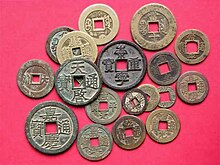
Back Tradiční čínské mince štěstí Czech Cash (moneda china) Spanish سکههای چینی Persian Sapèque French Uang (koin Tiongkok) ID Cash (moneta cinese) Italian 銭貨 Japanese Chinese kèpèng Dutch 方孔钱 Chinese 銅錢 ZH-CLASSICAL
| Cash | |||||||||||||||||
|---|---|---|---|---|---|---|---|---|---|---|---|---|---|---|---|---|---|
 Replicas of various ancient to 19th century cast cash coins in various metals found in China, Korea and Japan. | |||||||||||||||||
| Chinese name | |||||||||||||||||
| Traditional Chinese | 方孔錢 | ||||||||||||||||
| Simplified Chinese | 方孔钱 | ||||||||||||||||
| Literal meaning | "square-holed money" | ||||||||||||||||
| |||||||||||||||||
| Alternative Chinese name | |||||||||||||||||
| Traditional Chinese | 銅錢 | ||||||||||||||||
| Simplified Chinese | 铜钱 | ||||||||||||||||
| Literal meaning | "copper money" | ||||||||||||||||
| |||||||||||||||||
| Second alternative Chinese name | |||||||||||||||||
| Traditional Chinese | 銅幣 | ||||||||||||||||
| Simplified Chinese | 铜币 | ||||||||||||||||
| Literal meaning | "copper currency" | ||||||||||||||||
| |||||||||||||||||
| Vietnamese name | |||||||||||||||||
| Vietnamese alphabet | đồng tiền | ||||||||||||||||
| Chữ Nôm | 銅錢 | ||||||||||||||||
| Japanese name | |||||||||||||||||
| Kanji | 銅銭 | ||||||||||||||||
| Kana | どうせん | ||||||||||||||||
| |||||||||||||||||
| Indonesian name | |||||||||||||||||
| Indonesian | uang kèpèng / uang keping / pitis | ||||||||||||||||
The cash or qian was a type of coin of China and the Sinosphere, used from the 4th century BC until the 20th century AD, characterised by their round outer shape and a square center hole (Chinese: 方穿; pinyin: fāng chuān; Jyutping: fong1 cyun1; Pe̍h-ōe-jī: hong-chhoan). Originally cast during the Warring States period, these coins continued to be used for the entirety of Imperial China. The last Chinese cash coins were cast in the first year of the Republic of China. Generally most cash coins were made from copper or bronze alloys, with iron, lead, and zinc coins occasionally used less often throughout Chinese history. Rare silver and gold cash coins were also produced. During most of their production, cash coins were cast, but during the late Qing dynasty, machine-struck cash coins began to be made. As the cash coins produced over Chinese history were similar, thousand year old cash coins produced during the Northern Song dynasty continued to circulate as valid currency well into the early twentieth century.[1]
In the modern era, these coins are considered to be Chinese “good luck coins”; they are hung on strings and round the necks of children, or over the beds of sick people. They hold a place in various traditional Chinese techniques, such as Yijing divination, as well as traditional Chinese medicine, and feng shui. Currencies based on the Chinese cash coins include the Japanese mon, Korean mun, Ryukyuan mon, and Vietnamese văn.
- ^ Kann p. 385.
© MMXXIII Rich X Search. We shall prevail. All rights reserved. Rich X Search